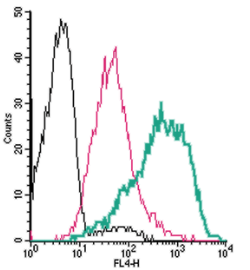Overview
- Peptide (C)HLRGQRWPFGEAA(S)R, corresponding to amino acid residues 136-150 of human PAR4 (Accession Q96RI0). Cys 149 was replaced with Ser. 1st extracellular loop.

 Cell surface detection of PAR4 by direct flow cytometry in live intact human MEG-01 megakaryocytic cells:___ Cells.
Cell surface detection of PAR4 by direct flow cytometry in live intact human MEG-01 megakaryocytic cells:___ Cells.
___ Cells + Rabbit IgG isotype control-APC.
___ Cells + Anti-PAR4 (F2RL3) (extracellular)-APC Antibody (#APR-034-APC), (2.5µg). Cell surface detection of PAR4 by direct flow cytometry in live intact mouse P815 mast cells:___ Cells.
Cell surface detection of PAR4 by direct flow cytometry in live intact mouse P815 mast cells:___ Cells.
___ Cells + Rabbit IgG isotype control-APC.
___ Cells + Anti-PAR4 (F2RL3) (extracellular)-APC Antibody (#APR-034-APC), (2.5µg).
- MacFarlane, S.R. et al. (2001) Pharmacol. Rev. 53, 245.
- Hollenberg, M.D. et al. (2002) Pharmacol. Rev. 54, 203.
- Ossovskaya, V.S. et al. (2004) Physiol. Rev. 84, 579.
Protease-activated receptor 4 (PAR-4) belongs to a family of four G protein-coupled receptors (PAR1-4) that are activated as a result of proteolytic cleavage by certain serine proteases, hence their name. In this novel modality of activation, a specific protease cleaves the PAR receptor within a defined sequence in its extracellular N-terminal domain. This results in the creation of a new N-terminal tethered ligand, which subsequently binds to a site in the second extracellular loop of the same receptor. This binding results in the coupling of the receptor to G proteins and in the activation of several signal transduction pathways.1-3
Different PARs are activated by different proteases. Hence, PAR-4 is activated by both thrombin and trypsin whereas PAR-1 and PAR-3 are activated only by thrombin and PAR-2 is activated only by trypsin.1-3 PAR-4 can be also cleaved and activated by other proteases such as cathepsin G.
The intracellular signaling mechanisms mediated by PAR-4 activation are not completely elucidated but they involve calcium mobilization downstream of phospholipase Cβ through the Gαq pathway.1-3
Tissue distribution of PAR-4 is very broad with the highest expression levels found in lung, testis, pancreas and small intestine. In addition, PAR-4 expression was observed in platelets, megakaryocytes and leukocytes. Studies with platelets derived from PAR-4 knockout mice have established an essential role for PAR-4 in thrombin-induced platelet activation.
PAR-4 is likely involved in other physiological functions such as regulation of gastrointestinal motility and regulation of vascular endothelial cell function.1-3
Application key:
Species reactivity key:
Anti-PAR4 (F2RL3) (extracellular) Antibody (#APR-034) is a highly specific antibody directed against an extracellular epitope of the human protein. The antibody can be used in western blot, immunohistochemistry, immunocytochemistry and live cell flow cytometry applications. It has been designed to recognize F2RL3 from human, mouse, and rat samples.
Anti-PAR4 (F2RL3) (extracellular)-APC Antibody (#APR-034-APC) is directly conjugated to Allophycocyanin (APC) fluorophore. This conjugated antibody has been developed to be used in immunofluorescent applications such as direct flow cytometry and live cell imaging.
